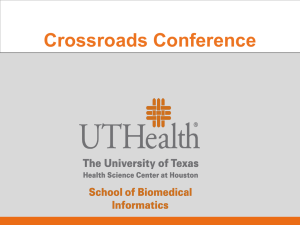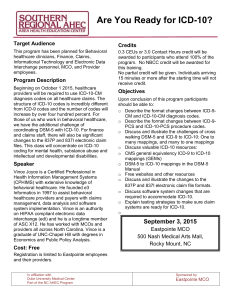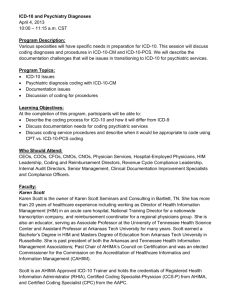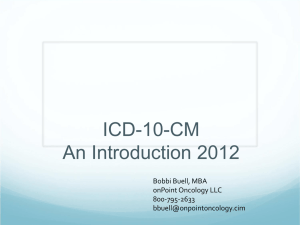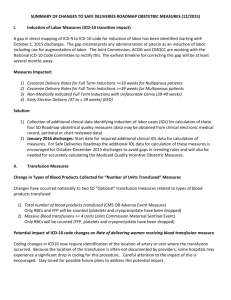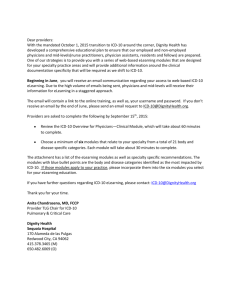ICD-10 Update* Hematology and Oncology
advertisement
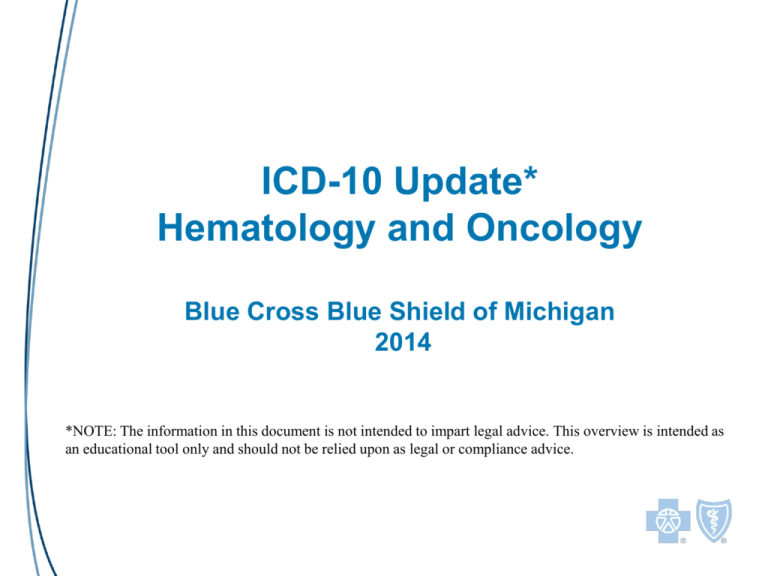
ICD-10 Update* Hematology and Oncology Blue Cross Blue Shield of Michigan 2014 *NOTE: The information in this document is not intended to impart legal advice. This overview is intended as an educational tool only and should not be relied upon as legal or compliance advice. Agenda • ICD-10 overview – The mandate – The differences – Hematology and Oncology examples • Hematology and Oncology – ICD-10 Chapter overviews – Top diagnostic codes • Great information…but so what? • Next steps • BCBSM readiness • It’s all about the coding • Provider Testing • Appendix – A chapter by chapter look at the ICD-10-CM code set 2 ICD-10 overview The ICD-10 Mandate • The ICD-10 implementation is scheduled for Oct. 1, 2015. On claims with that date of service, all HIPAAcovered health care entities must begin using ICD-10 codes in place of the ICD-9 codes • Claims with non-compliant codes will be rejected • Delivered in two parts – ICD-10-CM (for all providers in all health care settings) and ICD-10-PCS (for hospital claims and inpatient hospital procedures • Does not affect CPT or HCPCS codes and usage 4 The differences between ICD-9 and 10 • Differences between the code sets make ICD-10 look like an entirely different coding language • Main differences include: – Volume – Structure – New features 5 Volume differences • About 150,000 ICD-10 codes will replace 17,000 ICD-9 codes • The greater level of detail in ICD-10 causes the increased volume 6 Structural differences – ICD-9-CM 7 Structural differences – ICD-10-CM 8 ICD-10-CM New Features • Combination codes for some conditions and associated symptoms • Laterality • Expansion of some codes – – – – Injuries Diabetes Alcohol and substance abuse Post-op complications • Injuries grouped by anatomical site instead of by category 9 Examples of Combination Codes – ICD-10-CM (Hematology: from ICD-10 Chapter 3 – Diseases of the Blood and Blood-forming Organs and Certain Disorders involving the Immune Mechanism) • D57.211 – Sickle-cell/Hb-C disease with acute chest syndrome • D57.212 – Sickle-cell/Hb-C disease with splenic sequestration • D57.411 – Sickle-cell thalassemia with acute chest syndrome • D57.412 – Sickle-cell thalassemia with splenic sequestration 10 Examples of Neoplasm Laterality ICD-10-CM (Oncology: from ICD-10 Chapter 2 – Neoplasms) • C34.01 – Malignant neoplasm of right main bronchus • C34.02 – Malignant neoplasm of left main bronchus • C44.622 – Squamous cell carcinoma of skin of right upper limb, including shoulder • C44.629 – Squamous cell carcinoma of skin of left upper limb, including shoulder 11 There are other differences • Code titles are more complete • Specificity and detail significantly expanded • Certain diseases reclassified to reflect current medical knowledge • The letter “O” should be stated as “O” and not 0(zero) 12 A quick ICD-10-PCS informational overview • PCS - Procedure Coding System • Completely different from ICD-9-CM procedure codes • Codes are built one digit at a time, each digit represents a different piece of information • Codes are each 7 characters long (no decimal points) – Each character can be alpha or numeric except I and O so as not to be confused with 1 and 0. • Each codes is built specifically for the procedure performed so that the coding system is flexible and allows for new procedures to be easily incorporated into the coding system. 13 What’s different for Hematology and Oncology? Hematology: ICD-10 Chapter 3 Overview Diseases of the Blood and Blood-forming Organs and Certain Disorders involving the Immune Mechanism • Updates include – Classification improvements – Code expansions – Updates to medical terminology – Greater specificity • Procedural complications affecting the spleen are included in chapter 3 of ICD-10-CM. 15 Oncology: ICD-10 Chapter 2 Overview - Neoplasms Key updates to the Neoplasm chapter include: • Classification improvements • Code expansions - Significant expansion in the malignant neoplasm of male breast codes • Revisions to identify laterality for some of the neoplasm sites • The ICD-10-CM Neoplasm Table is now located at the end of the Alphabetical index in the code manual and should continue to be referenced first when coding neoplasms. . 16 Hematology Chapter 3 in ICD-10-CM Diseases of the Blood and Blood-forming Organs and Certain Disorders involving the Immune Mechanism Top 10 Most Frequently Reported Hematology Diagnoses ICD-9-CM ICD-10-CM 285.9 – Anemia unspecified D64.9 – Anemia unspecified 280.9 – Iron deficiency anemia unspecified D50.9 – Iron deficiency anemia unspecified 281.0 – Pernicious anemia D51.0 – Vitamin B12 deficiency due to intrinsic factor deficiency 17 Hematology – Top Ten ICD-10 Codes Cont’d ICD-9-CM 281.1 – Other vitamin B12 deficiency anemia ICD-10-CM D51.1 – Vitamin B12 deficiency anemia due to selective vitamin B12 malabsorption w/proteinuria D51.2 – Transcobalamin II deficiency D51.3 – Other dietary vitamin B12 deficiency anemia D51.8 – Other vitamin B12 deficiency anemia D51.9 – Vitamin B12 deficiency anemia unspecified 18 Hematology – Top Ten ICD-10 Codes Cont’d ICD-9-CM ICD-10-CM 286.9 - Other and unspecified coagulation defects D68.8 – Other specified coagulation defects D68.9 – coagulation defect unspecified 285.21 – Anemia in chronic kidney disease D63.1 – anemia in chronic kidney disease 19 Hematology – Top Ten ICD-10 Codes Cont’d ICD-9-CM 287.5 – Thrombocytopenia unspecified ICD-10-CM D69.6 – Thrombocytopenia unspecified 288.60 – Leukocytosis unspecified D72.829 – Elevated white blood cell count unspecified 280.0 – Iron deficiency anemia secondary to blood loss (chronic) D50.0 – Iron deficiency anemia secondary to blood loss (chronic) 20 Hematology – Top Ten ICD-10 Codes Cont’d ICD-9-CM 288.00 – Neutropenia unspecified ICD-10-CM D70.9 – Neutropenia unspecified 21 Oncology: ICD-10 Chapter 2 - Neoplasms Top 10 Most Frequently Reported Oncology Diagnoses Codes ICD-9-CM 185 - Malignant neoplasm of prostate 174.9 – Malignant neoplasm of breast (female) unspecified ICD-10-CM C61 – Malignant neoplasm of prostate C50.911 – Malignant neoplasm of unspecified site of right female breast C50.912 – Malignant neoplasm of unspecified site of left female breast C50.919 – Malignant neoplasm of unspecified site of unspecified female breast 22 Oncology – Top Ten ICD-10 Codes Cont’d ICD-9-CM 211.3 – Benign neoplasm of colon ICD-10-CM D12.0 – Benign neoplasm of cecum D12.1 – Benign neoplasm of appendix D12.2 – Benign neoplasm of ascending colon D12.3 – Benign neoplasm of transverse colon D12.4 – Benign neoplasm of descending colon D12.5 – Benign neoplasm of sigmoid colon D12.6 – Benign neoplasm of colon unspecified K63.5 – Polyp of colon 23 Oncology – Top Ten ICD-10 Codes Cont’d ICD-9-CM 162.9 – Malignant neoplasm of bronchus and lung unspecified ICD-10-CM C34.90 – Malignant neoplasm of unspecified part of unspecified bronchus or lung C34.91 – Malignant neoplasm of unspecified part of right bronchus or lung C34.92 – Malignant neoplasm of unspecified part of left bronchus or lung 24 Oncology – Top Ten ICD-10 Codes Cont’d ICD-9-CM ICD-10-CM 238.2 – Neoplasm of uncertain behavior of skin D48.5 – Neoplasm of uncertain behavior of skin 153.9 – Malignant neoplasm of colon unspecified C18.9 – Malignant neoplasm of colon unspecified 25 Oncology – Top Ten ICD-10 Codes Cont’d ICD-9-CM 202.80 – Other malignant lymphomas unspecified site extranodal and solid organ sites This ICD-9-CM code maps to 17 possible ICD-10-CM codes ICD-10-CM C82.50 – Diffuse follicle center lymphoma unspecified site C82.59 – Diffuse follicle center lymphoma extranodal and solid organ sites C84.90 – Mature T/NK-cell lymphomas unspecified ,unspecified site C84.99 – Mature T/NK-cell lymphomas ,unspecified, extranodal and solid organ sites C84.A0 – Cutaneous T-cell lymphoma ,unspecified, unspecified site C84.A9 – Cutaneous T-cell lymphoma unspecified extranodal and solid organ sites C84.Z0 – Other mature T/NK-cell lymphomas unspecified site C84.Z9 – Other mature T/NK-cell lymphomas extranodal and solid organ sites C85.10 – Unspecified B-cell lymphoma unspecified site C85.19 – Unspecified B-cell lymphoma extranodal and solid organ site C85.20 – Mediastinal (thymic) large B-cell lymphoma unspecified site C85.29 – Mediastinal (thymic) large B-cell lymphoma extranodal and solid organ site C85.80 – Other specified types of non-Hodgkin lymphoma unspecified site C85.89 – Other specified types of non-Hodgkin lymphoma extranodal and solid organ sites C85.90 – Non-Hodgkin lymphoma unspecified unspecified site C85.99 – Non-Hodgkin lymphoma unspecified extranodal and solid organ sites C86.4 – Blastic NK-cell lymphoma Oncology – Top Ten ICD-10 Codes Cont’d ICD-9-CM 216.5 – Benign neoplasm of skin of trunk except scrotum 174.8 – Malignant neoplasm of other specified sites of female breast ICD-10-CM D22.5 – Melanocytic nevi of trunk D23.5 – Other benign neoplasm of skin of trunk C50.811 – Malignant neoplasm of overlapping sites of right female breast C50.812 – Malignant neoplasm of overlapping sites of left female breast C50.819 – Malignant neoplasm of overlapping sites of unspecified female breast 27 Oncology – Top Ten ICD-10 Codes Cont’d ICD-9-CM 203.00 – Multiple myeloma without mention of having achieved remission ICD-10-CM C90.00 – Multiple myeloma not having achieved remission 28 Great information…but so what? Everyone has different views of ICD-10 • Clinician Perspective: ICD-10 is understanding the increased level of detail needed in the medical record documentation. • Coder Perspective: Training is required to understand the additional detail in the codes. • Payer Perspective: Make sure that our systems can take the submitted codes and pay claims/apply benefits appropriately. The best way to understand the impact of the ICD-10 code set is to see it in action… 30 Real-world examples – Many to one • Just because there is a significant increase in detail, it doesn’t mean that all codes have expanded. • In some cases, the number of codes have been reduced – Hypertension changed from malignant, benign, or unspecified in I-9 to essential hypertension in I-10 31 BCBSM’s lessons learned about the ICD-10CM code set • Some chapters of codes included significant changes to the axis of classification (or other factors) which increased our review time. • These include: – OB chapter: Change from episode of care to trimester – Injury/Poisoning and Other Consequences of External Causes: Addition of 7th character to identify type of fracture (open, closed, etc.) and episode of care (initial, subsequent or for sequela) • See the appendix for more information about each chapter and the changes 32 Important points from an industry perspective • ICD-10 most likely will increase the need for certified coders – This is due to the increased detail in the code set, especially during the initial months of the transition • Entities must take into consideration external factors (such as impacts of Health Care Reform and requirements of Medicare and Medicaid) when planning for ICD-10 • A maintenance process must be in place as part of a long-term solution to enable processing of codes – How do you update the codes today? – With increased volume, that process will likely have to change 33 Medical records – A call for detail Because of ICD-10 specificity, provider documentation must change to meet the new level of detail. For example… Diagnosis: • • • • • Obesity must be specified in ICD-10 if due to excess calories or if drug induced. Angina Pectoris is further classified as unstable angina, angina pectoris with documented spasm or other forms of angina pectoris. Asthma is specified as mild intermittent, mild persistent, moderate persistent and severe persistent. Tobacco dependence in ICD-9 becomes Nicotine dependence in ICD-10. The type of nicotine dependence must be documented for coding purposes. Procedures: • • • Transfusion of Packed Red Blood Cells need to specify if red blood cells are fresh or frozen. Hernia repairs require the device (graft/implant) to be coded to autologous tissue substitute, synthetic substitute or nonautologous tissue substitute. Radiological procedures (aortogram, arteriography performed under fluoroscopy) need to specify contrast material used (High Osmolar, Low Osmolar or other contrast) 34 Why you should care about the ICD-10 transition If we receive non-compliant codes (problem in the provider space) OR incorrectly associate ICD-10 diagnosis codes in our systems (problem in the payer space)…. then there is major disruption…and if there’s disruption… Provider has to call the payer Payer answers questions, requests other information Claims are delayed Disruption in cash flows No one is happy It is in everyone’s best interest to work toward a seamless transition 35 Next steps What can others do? Next steps to prepare for ICD-10* Learn about the ICD-10 code set Determine Impact Identify all places within your organization that use ICD-9 codes and understand the impact of the transition Determine strengths and weaknesses in medical record documentation Staff review and refresh medical terminology Identify training needs Reach out to others Plan for coder training (6-9 months prior to implementation) Talk to business partners about ICD-10 readiness (payers, vendors, billing services, etc.) Be sure to discuss testing capabilities *Information from CMS’ MLN Matters, SE1019 37 ICD-10 readiness tactics • Start recoding the superbill and determine the documentation required to code accurately – Diabetes: Type 1 or 2, due to underlying condition, drug/chemical induced – Manifestations now included in chapter, but some will need an additional code – Do you need to expand the superbill based on physician activities? • Start with the CMS GEMs – They will get you in the ball park – The GEMs list all possible code combinations • Where else do ICD-9 codes exist in your office? • Talk to your specialty societies and ask if there is a plan to provide you with a list of conversion codes • Training: coding classes, refresher on medical terminology (many terms have been updated in I-10), and anatomy and physiology 38 ICD-10 Implementation Resources • • • • • • • • • CMS.gov provider resources link: http://www.cms.gov/Medicare/Coding/ICD10/ProviderResources.html CMS.gov provider implementation timelines and checklists link: http://www.cms.gov/Medicare/Coding/ICD10/ICD-10ImplementationTimelines.html CMS.gov ICD-10 basics for medical practices link: http://www.cms.gov/Medicare/Coding/ICD10/Downloads/ICD10_Basics_for_Medical_Practices_060413[1].pdf American Hospital Association - AHA.org website link: http://www.ahaphysicianforum.org/webinar/2013/icd-10/index.shtml Specialized training resources (extra cost): American Health Information Association – AHIMA.org and American Association Professional Coders – AAPC.com links: http://ahima.org/ContinuingEd/Campus/courseinfo/ICD10.aspx http://www.aapc.com/icd-10/ Coding Tipsheets - AHIMA.org and Californiahia.org links: http://library.ahima.org/xpedio/groups/public/documents/ahima/bok1_049431.hcsp?dDocName=bok1_049431#c http://www.californiahia.org/icd-10-cmpcs American Medical Association – AMA.org website links: http://www.ama-assn.org/ama/pub/physician-resources/solutions-managing-your-practice/coding-billinginsurance/hipaahealth-insurance-portability-accountability-act/transaction-code-set-standards/icd10-codeset.page BCBSM website – BCBSM.com and provider readiness mailbox links: http://www.bcbsm.com/content/public/en/providers/help/faqs/icd-10 icd-10providerreadiness@bcbsm.com Check with your professional and medical associations about ICD-10 readiness. 39 ICD-10 Implementation Resources Professional Resources • If you’re having trouble getting started with your ICD-10 implementation, the American Association of Professional Coders (AAPC) has a great, free way to start you on your way. • By accessing the AAPC ICD-10 coding crosswalk, you can start your practice off on the right foot to having the information you need. • A free .pdf copy is available by going to this website link: http://www.aapc.com/ICD-10/crosswalks/pdf-documents.aspx and providing some basic contact information. – Once you submit your information, a list of specialties will be displayed and you will be able to download the free .pdf for any of the specialties you choose. The Crosswalk contains the top 50 ICD-9 codes and the corresponding ICD-10 codes and is especially useful for the most commonly defined diagnosis codes. BCBSM readiness Upcoming major activities 2014-2015 2012-2013 2011 2009 to 10 Strategy, planning and mapping methodology Technical changes, mapping the codes and financial neutrality External testing and Implementation Technical coding, neutrality, testing provider readiness, business readiness 42 Steps we are taking to minimize the risk of disruption • Choose a solution that allows us to transition and positions us for possible contingencies – Extension of ICD-10 deadline – Request to accept both ICD-9 and ICD-10 codes for a time period • Extensive testing plan • Outreach and communications • Internal training of staff 43 It’s all about the coding ICD-10 and appropriate coding • When you think about it – ICD-10 is another example of appropriate coding • This is not up-coding • Rather it’s about following national coding guidelines and making sure to accurately describe a patient’s condition • Here are some important notes about appropriate coding – Valid signatures are needed in medical records – Specificity in medical record notes, especially for ICD10-CM, is essential – It’s important to code claims with accurate level of specificity 45 Documentation Tips For all documented diagnoses, consider the acronym: M.E.A.T. Include details on how you either: – – – – Manage/Monitor the condition Evaluate the condition Assess the condition Treat the condition Why appropriate coding is so important to you • Ensuring appropriate benefit application and/or payment (if applicable) • Helps to reduce the possibility of requests for medical records • Could help reduce the instances of medical record reviews • Proper coding now will help your practice or facility deal with the increased detail needed for: – quality measures – government programs (such as risk adjustment) – incentive programs and ACOs 47 For example • Accurate documentation and coding impacts several programs: – – – – Stars HEDIS PQRI (CMS’ Physician Quality Reporting Initiative) PCMH 48 ICD-10 Provider Testing Options with BCBSM (updated for 2014) ICD-10 Testing Options Testing option What it tests What it will tell you Transactional testing of claims with ICD-10 codes The ability to accept fully compliant 837 transactions with ICD10 codes Testing available through 10/1/2015 Send an e-mail to: Icd-10claimstesting@bcbsm.com If you’re interested in external claims testing. Medical scenario testing – professional A medical scenario is presented (by specialty) and the submitter is asked to assign appropriate ICD-10 codes Whether or not a claim with an ICD-10 code was received and passed EDI compliance checks What codes were submitted What other health care providers of the same specialty submitted for that scenario Testing available through 10/1/2015 Use this link (copy and paste to your internet browser) to register for medical scenario testing for professionals: http://bcbsmicd10providerregistry.hi ghpoint-solutions.com Testing available through 10/1/2015 DRG shift testing – facility The impact of ICD-10 coding on DRG shifts ICD-10 codes submitted (based on a historical ICD-9 claim) Impact of the ICD-10 codes on the DRG assignment Time line How to join Once registered, we will provide detailed instructions on how to use the tool will be provided via email. Send an email to: icd-10providertesting@bcbsm.com if you would like to register for facilities testing. For the medical scenario testing and the DRG shift testing, we will provide you with background documentation and detail Professional Testing with BCBSM • The test tool is available for use now through the ICD-10 implementation date (Oct. 1, 2015). • Use of this tool is free of charge. • Testing is done through the web; no special software or lengthy test requirements are needed. • It is “content based” and “specialty specific,” which means that you will be presented with several medical scenarios and be asked to code the scenarios in ICD-10. • Scenarios are based on specialties (internal medicine, oncology, etc.) and providers must register for each specialty they are interested in testing. Professional Testing with BCBSM Continued • We recommend you have some familiarity with the ICD-10 codes and have a code book or other access to the code set to complete this test. • BCBSM will provide a peer group report of the codes selected for the same scenarios which can be accessed multiple times as additional providers participate in the testing. • To register and begin the ICD-10 professional testing process, access the following link: bcbsmicd10providerregistry.highpoint-solutions.com Facility Testing with BCBSM • The process will continue through the ICD-10 implementation of Oct. 1, 2015. • Use of this tool is free of charge. • This testing identifies the impact of ICD-10 code selection on DRG shifts. • Facilities will register the historical claims which they would like to include in the test effort. • BCBSM will validate/register those claims and provide a link to a web based tool. Facility Testing with BCBSM Continued • Facilities will recode the original medical record and submit the ICD-10 codes either directly into the tool or via uploading a spreadsheet with the responses into the tool. • BCBSM will run the response thru the DRG grouper and provide a side by side comparison report of how each claim was grouped using the original ICD-9 codes along with the new ICD10 codes. • Send an email to icd-10providertesting@bcbsm.com if you would like to register for facilities testing. Questions Appendix A chapter by chapter look at the ICD10-CM code set (Chapters 2 & 3 overviews previously provided) Chapter 1 - Certain infectious and parasitic diseases • Includes diseases generally recognized as communicable or transmissible. • Updates to Chapter 1 of ICD-10-CM include: – Terminology changes • Sepsis (ICD-10-CM) has replaced Septicemia (ICD-9-CM) • Urosepsis is a nonspecific term and is not coded in ICD-10-CM. Should a provider use this term, he/she must be queried for clarification. • “Late Effects” of Infectious and Parasitic Diseases (ICD-9-CM) is now “Sequela” of infectious and Parasitic Diseases in ICD-10-CM – Coding guideline changes • Infections resistant to antibiotics requires the use of an additional code for any associated drug resistance only if the infection code does not identify drug resistance (Z16 category, resistance to antimicrobial drugs) – Expansion of the codes to reflect manifestations of the disease. • Many of the codes are combined conditions and common symptoms 57 Chapter 4 - Endocrine, nutritional and metabolic diseases • Considerable changes were made to the organization, code expansions and updates to medical terminology in Chapter 4. • The largest change noted is to the Diabetes Mellitus classification. – ICD-10-CM Diabetes mellitus codes are now combination codes that include the type of diabetes (1 or 2), the body system affected and complications affecting the body system (Retinopathy, Neuropathy, Arthropathy, Peripheral angiopathy with gangrene, etc.) – As many codes within a particular category as are necessary to describe all of the complications of the disease may be used. 58 Other diabetes changes • Diabetes Mellitus (E08-E13) is no longer classified as controlled or uncontrolled in ICD-10-CM. Therefore this is no longer a factor in the ICD-10-CM code selection. • ICD-10-CM classifies inadequately controlled, out of control, and poorly controlled diabetes mellitus to diabetes, by type with hyperglycemia. • Secondary diabetes is always caused by another condition or event (e.g., cystic fibrosis, malignant neoplasm of pancreas, pancreatectomy, adverse effect of drug, or poisoning). 59 Overweight and obesity codes • The classification for overweight and obesity has been expanded in ICD-10-CM to include: – Obesity due to excess calories – Morbid (severe) obesity due to excess calories – Other obesity due to excess calories – Drug induced obesity – Morbid (severe) obesity due to alveolar hypoventilation – Overweight – Other obesity – Obesity unspecified • An additional code (Z68 category) is used to identify the body mass index (BMI), if known. 60 Chapter 5 - Mental, behavioral and neurodevelopmental disorders Updates to Chapter 5 include: • Classification improvements (different categories) • Code expansions – Most notably, Other Isolated or Specific Phobias • Updates to medical terminology – Bipolar I disorder, single manic episode will change to Manic episode – Undersocialized conduct disorders, aggressive will become Conduct disorder childhood-onset type • Other significant changes – Nicotine dependence updated to identify specific tobacco products (cigarettes, chewing tobacco, other tobacco) – Alcohol abuse and dependence codes no longer identify continuous or episodic use 61 Chapter 6 - Diseases of the nervous system • ICD-10-CM devotes Chapter 6 to Diseases of the Nervous System. The sense organs (eye/adnexa and ear/mastoid processes) have their own chapters in ICD10-CM. • Updates to Chapter 6 include – Classification improvements (significant changes to sleep disorders) – Code expansions (e.g. Alzheimer’s, headaches) – Updates to medical terminology (epilepsy, seizures) 62 Chapter 7 - Diseases of the eye and adnexa • Diseases of the Eye and Adnexa is a new chapter in ICD-10-CM. • Key updates to this chapter include – Terminology improvements (bringing terms up to date) – Revisions to identify laterality • ICD-10-CM contains codes for right side, left side and in some instances bilateral sides for diseases of the eye and adnexa. • An unspecified site is also provided should the site not be identified in the medical record. • If no bilateral code is provided and the condition is bilateral, assign separate codes for both the left and right side. 63 Chapter 8 - Diseases of the ear and mastoid process • This is a new chapter in ICD-10, which has been separated from the Nervous System and Sense Organs chapter included in ICD-9-CM. • There is also a greater specificity and detail in the codes. • Many codes have laterality designation. 64 Chapter 9 - Diseases of the circulatory system • Similar structure to ICD-9-CM, but there are classification changes to be aware of • Terminology used to describe several cardiovascular conditions has been revised to reflect more current medical practice • A major change is the classification of hypertension, which in ICD-9-CM was classified by type: benign, malignant or unspecified. That classification is not required in ICD-10-CM. The code for hypertension has been updated to one code for essential (primary) hypertension. 65 Chapter 10 - Diseases of the respiratory system • Modifications have been made to specific categories that bring the terminology up-to-date with current medical practice. – Emphysema now contains codes with panlobular and centrilobular in their titles – Asthma is now classified as mild intermittent, mild persistent, moderate persistent and severe persistent. • Specificity increased for diseases like influenza, acute bronchitis • Coding guidelines updates to require the coder to include information about tobacco use/dependence, where applicable. 66 Chapter 11 - Diseases of the digestive system • A number of new subchapters have been added to this chapter (including liver diseases) • Some terminology changes and revisions to the classification of specific digestive conditions have occurred in ICD-10-CM as well. – The term hemorrhage is used when referring to ulcers – The term bleeding is used when classifying gastritis, duodenitis, diverticulosis and diverticulitis • There is new specificity to conditions like Crohn’s disease, which have been expanded to specify site, if a complication is present, and what the complication is. 67 Chapter 12 - Diseases of the skin and subcutaneous tissue • This chapter has been completely restructured to bring together groups of diseases that are related to one another in some way. • Greater specificity has been added to many of the codes at the 4th, 5th or 6th character level. • It has 9 subchapters (compared to 3 in ICD-9-CM) • There are many changes to the ulcer’s sectionpressure ulcer codes are combination codes that identify site and stage of the ulcer. • Procedural complications of the skin and subcutaneous tissue are included. 68 Chapter 13 - Diseases of the musculoskeletal system and connective tissue • Most of the codes within this chapter have site and laterality designations. • ICD-10-CM identifies three different causes for pathological fractures; neoplastic disease, osteoporosis, and other specified disease. • ICD-10-CM introduces the 7th character that describes type of encounter or the state of a fracture’s healing and any sequela. Some of the codes in this chapter have a 7th character applied. BCBSM Proprietary Document 69 Chapter 14 - Diseases of the genitourinary system • Procedural complications affecting the genitourinary system are included in chapter 14. • Laterality is used to identify conditions under N60 category, benign mammary dysplasia. • In some of the categories, specificity is based on the gender of the patient. 70 Chapter 15 - Pregnancy, childbirth and the puerperium • Trimester is now the axis of classification rather than the current episode of care, i.e. delivered, antepartum, postpartum – The majority of codes in this chapter have a final character for trimester of pregnancy (see chart). Trimesters 1st Less than 14 weeks 0 days 2nd 14 weeks 0 days to less than 28 weeks 0 days 3rd 28 weeks 0 days until delivery 71 Chapter 16 - Certain conditions originating in the perinatal period • Codes from this chapter are for use on newborn records only, never on maternal records and include conditions that have their origin in the fetal or perinatal period (before birth through the first 28 days after birth) even if morbidity occurs later. • Different codes are used for “light for gestational age” and “small for gestational age”. • Codes for assigning birth trauma have been expanded to include more specificity. 72 Chapter 17 - Congenital malformations, deformations and chromosomal abnormalities • Modifications have been made to specific categories that bring the terminology up-to-date with current medical practice. • Other enhancements to Chapter 17 include classification changes that provide greater specificity than found in ICD-9-CM. 73 Chapter 18 - Symptoms, signs and abnormal clinical and laboratory findings • Chapter 18 includes symptoms, signs, abnormal results of clinical or other investigative procedures, and illdefined conditions regarding which no diagnosis classifiable elsewhere is recorded. • Practically all categories in Chapter 18 could be designated as: • Not otherwise specified • Unknown etiology or • Transient • There are codes to identify a patient’s coma scale. • ICD-10-CM contains a number of combination codes that identify both the definitive diagnosis and common symptoms of that diagnosis. 74 Chapter 19 - Injury, poisoning, and certain other consequences of external causes • Injuries grouped by body part rather than category of injury in ICD-9 • ICD-10-CM introduces a 7th character requirement that describes the type of encounter. Most categories in this chapter use the 7th character requirement. Many categories in this chapter have three 7th character values of: • A – Initial encounter • D – Subsequent encounter • S – Sequela • For traumatic fractures, there are additional 7th character requirements depending upon the type of fracture and complication. Some of these character descriptions are based on the Gustilo open fracture classification. • Code for underdosing are new in ICD-10-CM. Underdosing refers to taking less of a medication than is prescribed by a provider or less than the manufacturer’s instructions. 75 Chapter 20 - External causes of morbidity • External cause codes are intended to provide data for injury research and evaluation of injury prevention strategies. • These codes capture how the injury or health condition was caused, the intent, the place where the event occurred, the activity of the patient at the time of the event, and the person’s status. • These codes are secondary codes for use in any health care setting and can never be a principal (first listed) diagnosis. 76 Chapter 21 - Factors influencing health status and contact with health services • These codes are used in any healthcare setting. Z codes may be used as either a first listed (principal diagnosis code in the inpatient setting), or secondary code, depending on the circumstances of the encounter. Certain Z codes may only be used as first listed or principal diagnosis in certain conditions- refer to official coding guidelines. • Some of the category sections include,contact/exposure, vaccinations, status code, screening, aftercare • Aftercare note - In ICD-10-CM Aftercare Z codes should not be used for aftercare of fractures. • For aftercare of a fracture, assign the acute fracture code with the 7th character extension of D for subsequent encounter. 77

